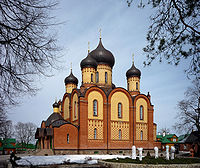Pühtitsa Convent

Pühtitsa Convent (Estonian: Kuremäe Jumalaema Uinumise nunnaklooster, Russian: Пюхтицкий Успенский женский монастырь) is a convent located in Eastern Estonia (Ida-Viru County) between Lake Peipus and the Gulf of Finland. A small Orthodox Christian church was built in Pühtitsa in the 16th century. The convent was founded in 1891.
History


The convent is located on a site known as Pühitsetud ("blessed" in Estonian) since ancient times. According to a 16th-century legend, near the local village, Kuremäe, a shepherd witnessed a divine revelation near a spring of water to this day venerated as holy. Later, locals found an ancient icon of Dormition of the Mother of God under a huge oak tree. The icon still belongs to the convent.
In 1888, the Russian Orthodox Church sent a nun from Kostroma Ipatiev Monastery to establish a convent in Pühtitsa. The main Cathedral of the convent was built to a design by Mikhail Preobrazhensky in a Russian Revival style and was fully completed in 1910.
There are six churches in the convent dedicated to a number of Orthodox Christian Saints such as St. Sergius of Radonezh, St. Simeon the Receiver of God, St. Nicholas, St. Anna the Prophetess and others. Prince Sergei Shakhovskoy governor-general of Estonia was convent's patron and protected it from local nobles, mostly German Lutherans, who tried to resist its construction. The convent was first Orthodox monastery built in Estonia to the delight of mostly Orthodox local Estonian and Russian peasants of Jõhvi county.
In 1919, after Estonia became independent from Russia, the new government confiscated most of the convent's land and transferred the convent to the Estonian Apostolic Orthodox Church, independent of Moscow. During the Second World War the battlefront was at times only a few kilometres away from the convent and Germans organized a concentration camp for Russian prisoners of war inside the monastery compound.
Following the second invasion and occupation of Estonia by the Soviet Union in 1944, the convent managed to survive despite the uneasy co-existence with the Communist authorities. Patriarch Alexius II who was the bishop (later the archbishop) of Tallinn and Estonia in the 1960s was instrumental in the fight to keep the convent from closure. In 1990 the Pühtitsa Convent was placed under the direct authority of the Patriarch of Moscow and All Russia, Alexius II. By 1991, the Pühtitsa monastic community consisted of 161 nuns.
See also
External links
- Template:En icon Estonian Orthodox Church of Moscow Patriarchate - Pühtitsa (Pyhtitsa) Dormition Convent[dead link]
- Template:Fr icon Le Couvent de Pühtitsa à Kuremäe
- Template:Ru icon Orthodox holy places - the Silver Ring of Russia
Photos and videos
- Entrance to the Pühtitsa Convent QTVR fullscreen panorama (July 08, 2007)
- Convents
- Churches in Estonia
- Russian Orthodox monasteries
- Religious organizations established in 1891
- Illuka Parish
- Buildings and structures in Ida-Viru County
- Christian monasteries in Estonia
- 1890s establishments in Estonia
- Russian Revival architecture
- 1891 establishments in Russia
- Russians in Estonia
- Tourist attractions in Ida-Viru County
